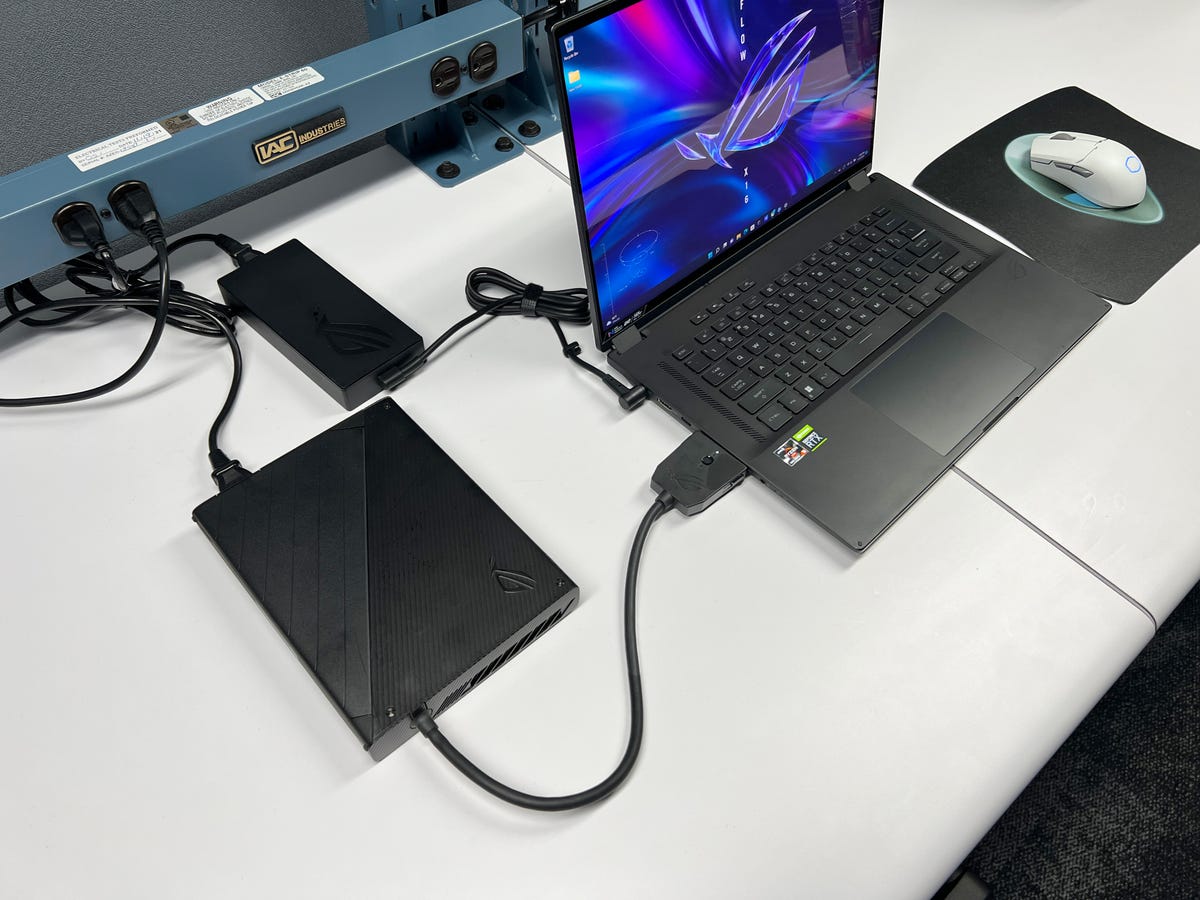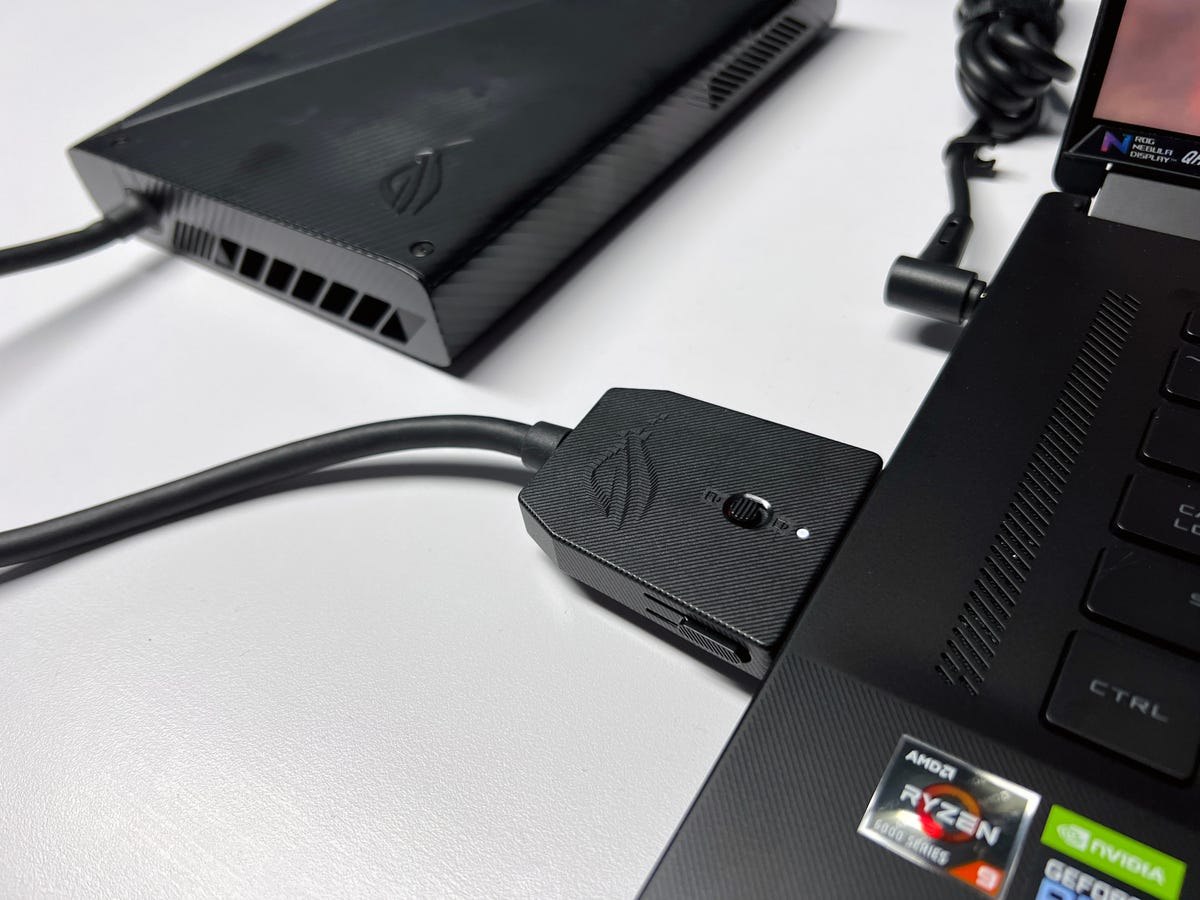Gaming laptops with 16-inch screens are common enough. What's unusual is finding one with a 360-degree hinge to become a foldable 2-in-1 hybrid. Add another level of ingenuity and you've got the ability to plug in a more-powerful external GPU for even better performance.
That makes the Asus ROG Flow X16 a very unique gaming laptop, but also an expensive one. The base system we tested is $1,999, frankly way too much for a gaming laptop with an Nvidia RTX 3060 GPU.
And the sold-separately Asus XG Mobile external GPU box, which adds a high-end Nvidia RTX 3080 graphics card, is $1,199, for a total of nearly $3,200.
As of this writing, I've seen the X16 on sale for $1,750, which is at least a little more reasonable. Asus also makes a version of the X16 with an RTX 3070 Ti GPU, fast enough that you wouldn't need the external graphics add-on, and that model is $2,699.
Like
- Modular design allows for GPU upgrades
- Hybrid 360-degree hinge
- XG Mobile GPU can be used with multiple Asus products
Don't Like
- Expensive for the components you get
- XG Mobile GPU uses a proprietary connection
- Limited ports
If you follow gaming laptop pricing, it's tough to imagine spending that much on a laptop with just 16GB of RAM and a single 1TB SSD. At the same time, there's a great value both to the flexibility of being able to turn the X16 into a gaming tablet and the ability to swap the better RTX 3080 graphics in and out as needed.
If you skip the 360-degree hinge and the proprietary port for an external GPU box, similar 16-inch gaming laptops with the Nvidia RTX 3060, like the HP Victus or Dell G16, can be found for around $1,300. But while it's true you can spend less for similar components, there are a lot of unique features to the Flow X16 that really appeal to me.
We previously reviewed (and liked) the 13-inch take on this concept, called the (you guessed it) Asus Flow X13, as well as a tablet-based version, called the Z13, which is kind of like a gaming Microsoft Surface. All of these work with the Asus XG Mobile external GPU. If you feel the need to have both a 16-inch desktop replacement and a 13-inch tablet or ultraportable laptop, it's nice that they can share the XG Mobile for better graphics performance. Still, it's an expensive, and proprietary, ecosystem to buy into.
System Specs
| Geekbox | Asus ROG Flow X16 |
|---|---|
| Price as reviewed | $1,999 |
| Display size/resolution | 16-inch 2,560 x 1,600 touch display |
| CPU | 3.3GHz AMD Ryzen 9 6900HS with Radeon Graphics |
| Memory | 16GB DDR5 4,800MHz RAM |
| Graphics | 6144MB Nvidia GeForce RTX 3060 graphics |
| Storage | 1TB SSD |
| Networking | Wi-Fi 6E(802.11ax) + Bluetooth 5.2 |
| Operating system | Microsoft Windows 11 Home 21H2 |
Ports and interfaces
Open the ribbed lid and the keyboard is flanked by dead space (with speaker grilles) on both sides. That's because it lacks a separate number pad, which many 16-inch, and even a good number of 15-inch, laptops have. The touchpad is larger than I've seen on many gaming laptops, where it's usually an afterthought.

The X16 and the XG Mobile each require a power cable.
Dan Ackerman/CNETAsus also follows a growing number of gaming laptops in adding discrete buttons for volume control, instead of mapping those commands to Alt/Function keys. Above the Function row, you get three buttons -- volume up, volume down, mic mute and a shortcut button for the Asus Armoury Crate app, which offers access to various system tools.
Connectivity is on the light side, with no rear panel ports. On the left, there's HDMI, USB-C, audio and the XG Mobile connection (which has a second USB-C port within it if you don't have the external GPU plugged in). The right side has microSD and two USB-A ports.
If you're allergic to lots of wires cluttering your space, keep in mind that the laptop has a standard power brick and cable, and the XG Mobile box requires its own power cable, so you'll need at least two outlets.

The connection between the X16 and XG Mobile.
Dan Ackerman/CNETGaming performance
In our benchmark tests, the Asus Flow X16 was a strong performer for a gaming laptop with an Nvidia 3060 card. Its AMD Ryzen 9 CPU matched well with the 11th-gen or 12th-gen Core i7 chips in similar gaming laptops. It was, as expected, much faster than a gaming laptop we tested with an AMD Ryzen 7 CPU.
Battery life was above average for a big-screen gaming laptop, somewhat surprisingly. It ran for about 7.5 hours. Obviously that's for video streaming, in an actual game, you'd be lucky to get a few hours.

Flip the screen around into a more display-friendly mode.
Dan Ackerman/CNETBut the really interesting thing was when we plugged the XG Mobile in and re-ran some tests. In the new Call of Duty: Modern Warfare 2, using just the internal 3060 card, the game ran at 70 frames per second at Ultra detail settings. Switch to the XG Ultra, with its Nvidia 3080, and the same settings gave us 109fps, a huge leap.
In 3D Mark Wild Life Extreme, a general test we use across a very wide range of devices, the X16 got a score of 15,224, near the bottom of our comparison pack. With the XG Mobile, it leapt to the top, scoring 22,753, edging out the powerful Acer Triton 500 SE, which uses an Intel Core i9 CPU and Nvidia 3080Ti GPU.
A highly specific take on the gaming laptop
This is a non-standard take on a gaming laptop, so the usual calculations about price, performance and features may not fully apply. If you're looking for a basic mainstream gaming laptop with an Nvidia 3060 card, this ain't it.
If you like the idea of a gaming hybrid that can fold into a kiosk mode and work with a gamepad, that's something almost no other gaming laptop can do. If you're especially interested in the XG Mobile as an add-on device that can work across different types of Asus computers, the X16 is a key part of that ecosystem and one of only a handful of ways to get that kind of modular performance.
Geekbench 5 (multicore)
Acer Predator Triton 500 SE
Alienware X15 R2
Asus ROG Flow X16 GV601
HP Victus 16
Acer Nitro 5 AN515-58
Dell Inspiron 16 Plus (7610)
Razer Blade 15 (2022)
Acer Swift X SFX14-41G-R1S6
Note:
Longer bars indicate better performanceCinebench R23 (multicore)
Acer Predator Triton 500 SE
Alienware X15 R2
Asus ROG Flow X16 GV601
Acer Nitro 5 AN515-58
Acer Swift X SFX14-41G-R1S6
Razer Blade 15 (2022)
Dell Inspiron 16 Plus (7610)
HP Victus 16
Note:
Longer bars indicate better performancePCMark 10 Pro
Acer Predator Triton 500 SE
Alienware X15 R2
Asus ROG Flow X16 GV601
Acer Nitro 5 AN515-58
Razer Blade 15 (2022)
Dell Inspiron 16 Plus (7610)
Acer Swift X SFX14-41G-R1S6
HP Victus 16
Note:
Longer bars indicate better performance3DMark Wild Life Extreme
Asus ROG Flow X16 GV601 + XG Mobile
Acer Predator Triton 500 SE
Alienware X15 R2
Razer Blade 15 (2022)
Acer Nitro 5 AN515-58
Asus ROG Flow X16 GV601
HP Victus 16
Dell Inspiron 16 Plus (7610)
Note:
Longer bars indicate better performanceGuardians of the Galaxy (High @1920 x 1080)
Alienware X15 R2
Acer Predator Triton 500 SE
HP Victus 16 (Core i7/3060)
Asus ROG Flow X16 GV601
Razer Blade 15 (2022) (Core i7/3070 Ti)
Acer Nitro 5 AN515-58 (Core i5/3060)
Note:
Longer bars indicate better performanceSystem Configurations
| Asus ROG Flow X16 GV601 | Microsoft Windows Home; 3.3GHz AMD Ryzen 9 6900HS; 16GB DDR5 4,800MHz RAM; 6144MB Nvidia GeForce RTX 3060; 1TB SSD | |
|---|---|---|
| Acer Nitro 5 AN515-58 | Microsoft Windows 11 Home; 2.5GHz Intel Core i5-12500H; 16GB DDR4 3,200MHz; 6GB Nvidia GeForce RTX 3060; 512GB SSD | |
| HP Victus 16 | Microsoft Windows 11 Home; 2.3GHz Intel Core i7-11800H; 16GB DDR4 3,200MHz; 6GB Nvidia GeForce RTX 3060; 512GB SSD | |
| Razer Blade 15 (2022) | Microsoft Windows 11 Home; 2.4GHz Intel Core i7-12800H; 16GB DDR5 4,800MH; 8GB Nvidia GeForce RTX 3070Ti; 1TB SSD | |
| Dell Inspiron 16 Plus (7610) | Microsoft Windows 11 Home; 2.3GHz Intel Core i7-11800H; 16GB DDR4 3,200MHz; 4GB Nvidia GeForce RTX 3050; 512GB SSD | |
| Acer Swift X SFX14-41G-R1S6 | Microsoft Windows 10 Home (64-bit); 1.9GHz AMD Ryzen 7 5900U; 16GB LPDDR4X RAM; 4GB Nvidia RTX 3050Ti; 512GB SSD | |
| Alienware X15 R2 | Microsoft Windows 11 Home; 2.3GHz Intel Core i7-12700H; 32GB DDR5 6,400MHz; 8GB Nvidia GeForce RTX 3070 Ti; 512GB SSD | |
| Acer Predator Triton 500 SE | Microsoft Windows 11 Home; 2.9GHz Intel Core i9-12900H; 16GB DDR5 4,800MHz; 16GB Nvidia Geforce RTX 3080Ti; 1TB SSD |
"flow" - Google News
December 05, 2022 at 07:00PM
https://ift.tt/tql9JxL
Asus ROG Flow X16 Review: Flexible Big-Screen Gaming - CNET
"flow" - Google News
https://ift.tt/o3ltcBT
https://ift.tt/VQoaXqw
Bagikan Berita Ini















0 Response to "Asus ROG Flow X16 Review: Flexible Big-Screen Gaming - CNET"
Post a Comment